Have you ever driven past a home and felt instantly drawn to its charm? That’s the magic of great curb appeal. It’s not just about making your house look pretty—it’s about creating a space that feels welcoming and reflects your personality. I’ve always believed that even the smallest changes, like adding a bird feeder or planting butterfly-attracting blooms, can transform your entryway into something truly special.
Research shows that homes with well-maintained landscaping can sell for up to 7% more than those without. That’s why I’m excited to share 20 creative Front Yard Flower Bed Ideas to help you design a stunning yard flower bed that boosts your home’s value and makes your neighbors stop and stare. Whether you’re dreaming of a formal garden or a cozy cottage vibe, there’s something here for everyone.
From climbing roses on a pergola to vibrant red bougainvillea arches, these designs are more than just beautiful—they’re practical too. Let’s dive in and discover how a few thoughtful tweaks can make your front yard the envy of the block!
Key Takeaways
- Well-maintained landscaping can increase home resale value by up to 7%.
- Small touches like bird feeders or butterfly-attracting plants can refresh your space.
- Creative designs, such as climbing roses or bougainvillea arches, enhance curb appeal.
- Formal and cottage-style gardens are both great options for a flower bed.
- A welcoming entryway can inspire and impress visitors.
Introduction to Inspiring Flower Beds
Your outdoor space can become a canvas for creativity and color. One of the best ways to bring life to your home’s exterior is by designing a stunning flower bed. It’s not just about planting a few blooms—it’s about creating a space that feels alive and inviting.
Adding a yard flower arrangement can transform your outdoor area into a vibrant oasis. Whether you’re a seasoned gardener or just starting, there are simple yet effective flower bed ideas that anyone can try. For example, pairing sweet peas with Oriental lilies creates a stunning visual contrast that’s both elegant and easy to maintain.
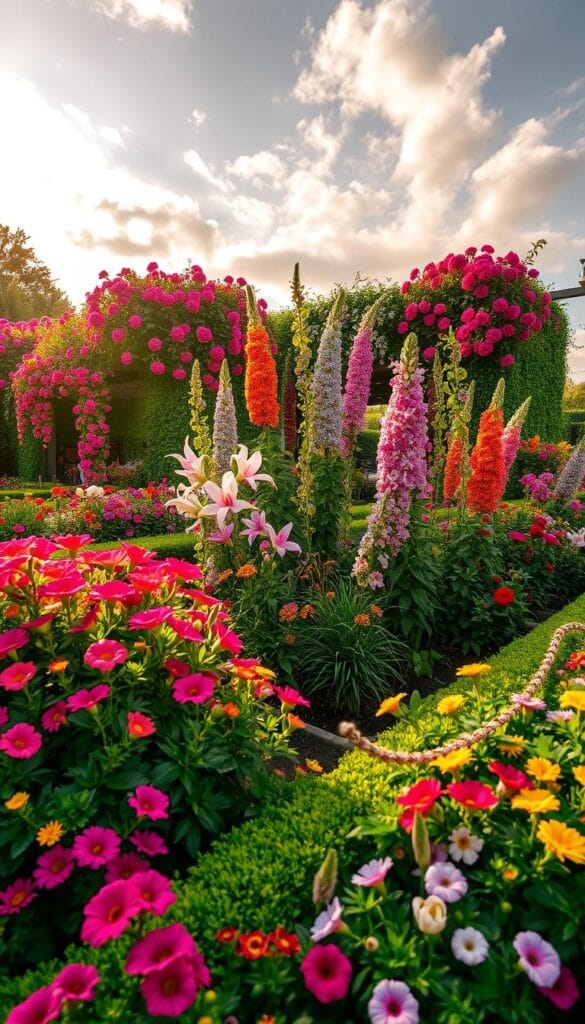
When planning your flower bed, consider the specific conditions of your yard. Plants thrive best when they’re suited to their environment. For instance, full-sun shrubs and perennials need at least 6-8 hours of sunlight daily. Choosing the right plants ensures your garden stays healthy and beautiful all year round.
Here are a few tips to get started:
- Think about plant height, color, and texture to create a balanced look.
- Group plants in odd numbers for a more visually appealing arrangement.
- Use raised beds for better drainage and easier access.
Your outdoor space is a reflection of your personality. So, don’t be afraid to experiment and let your creativity shine. With the right plan, your yard flower display can become the highlight of your home!
The Allure of Curb Appeal Through Stunning Yard Flower Beds
Curb appeal isn’t just about beauty—it’s about making a statement. A well-planned bed can dramatically increase your home’s charm and value. Research shows that homes with strong curb appeal can sell faster and are valued higher by buyers.

Complementary elements like a white picket fence can frame your garden beautifully. These small touches add structure and elegance, making your outdoor space feel cohesive and inviting. A gently curving pathway or container garden solution can also highlight the visual appeal of your yard.
Diverse planting techniques serve as an ongoing source of inspiration. For example, mixing perennials with annuals ensures year-round color and interest. Strategic plant placement and thoughtful edging create a polished look that’s both functional and stunning.
Your yard can act as the focal point for both daytime and evening aesthetics. Adding outdoor lighting enhances the beauty of your garden while improving safety. Well-defined pathways and borders guide guests effectively, making your space more accessible.
With the right plan, your outdoor area can become a vibrant oasis. Whether it’s through lush greenery or colorful blooms, a stunning bed transforms your home’s exterior into a welcoming masterpiece.
Front Yard Flower Bed Ideas: Maximizing Curb Appeal
The secret to a stunning outdoor space lies in thoughtful plant selection and color harmony. When you choose the right combination of blooms, you can create a vibrant oasis that captures attention and defines your space. Start by selecting standout plants that bring together texture and hue for a balanced look.
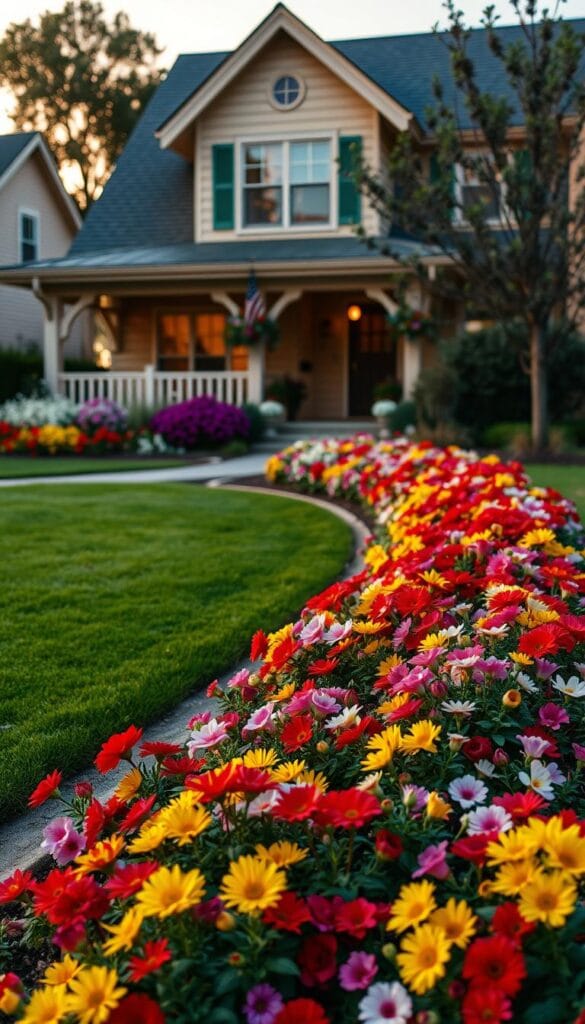
Mixing perennials with annuals is a great way to ensure long-lasting blooms. For example, pairing vibrant red geraniums with soft lavender creates a striking contrast that’s both elegant and eye-catching. Bright colors like orange and yellow can also draw attention, especially in sunny areas where they shine the most.
Visual continuity is key to a cohesive design. Group plants in odd numbers for a more natural and appealing arrangement. Use taller plants as a backdrop and layer shorter ones in front to create depth and interest. This technique not only enhances the look but also makes your space feel more dynamic.
Don’t forget to optimize your layout. Even small areas can make a big impact with the right design. Raised beds or vertical planters are perfect for maximizing limited space while adding structure to your garden. With a little creativity, your outdoor area can become the heart of your home’s charm.
Planning Your Flower Bed Layout for Impact
Designing a garden layout that truly stands out starts with smart planning. A well-organized space not only looks beautiful but also feels inviting. By focusing on layering techniques and thoughtful plant placement, you can create a garden that’s both functional and stunning.

Layering Techniques and Plant Placement
Layering is key to creating depth and visual interest in your garden. Start by placing taller plants, like sunflowers or hollyhocks, at the back. This creates a natural backdrop for your design.
Mid-height plants, such as lavender or coneflowers, work well in the middle layer. These add texture and color without overwhelming the space. Finally, ground covers like creeping thyme or sedum fill the front, tying everything together.
Grouping plants in odd numbers, like three or five, enhances the overall appeal. This technique creates a balanced and natural look that’s pleasing to the eye.
Choosing the Right Edging and Walkway Options
Edging defines your garden and keeps it looking neat. Materials like brick, wood, or stone add structure and style. For a rustic feel, consider using natural stones. For a modern touch, sleek metal edging works beautifully.
Walkways are another essential element. Gravel paths are cost-effective and easy to maintain, while flagstone offers a more polished look. Ensure your walkway complements the overall design and provides easy access to your plants.
Proper planning ensures your garden transitions smoothly from the street to your home. With the right layout, your outdoor space will become a welcoming masterpiece that reflects your personality and creativity.
Seasonal Considerations for Ever-Changing Beauty
Creating a garden that evolves with the seasons keeps your space fresh and exciting. By planning for year-round interest, you can ensure your outdoor area always has something to offer. Whether it’s the vibrant blooms of spring or the rich hues of fall, each season brings its own unique charm.

Spring Bulb Choices and Fall Planting Tips
Spring bulbs like daffodils and grape hyacinths are a fantastic way to kick off the growing season. These hardy plants multiply each year, enhancing your landscape over time. Pair them with early-blooming perennials for a stunning look that lasts.
As fall approaches, consider planting hardy perennials like peonies and alliums. These plants provide a seamless transition into cooler months, ensuring your garden remains vibrant. Dividing hostas every 3-4 years can also extend their lifespan, giving you more planting opportunities.
Year-Round Color Strategies
To maintain texture and variety, mix evergreen shrubs with seasonal blooms. Low-growing boxwoods, for example, offer year-round aesthetics with minimal maintenance. Adding flowering herbs like lavender and rosemary can attract pollinators while adding depth to your design.
Strategic plant selection based on bloom times ensures continuous color. Combining ‘May Night’ salvia, peonies, and alliums can create three seasons of vibrant hues. This idea keeps your garden engaging and dynamic throughout the year.
With a little planning, your outdoor space can become a year-round masterpiece. Focus on plants that thrive in your climate and complement each other’s growth cycles. This approach ensures your garden always looks its best, no matter the season.
Incorporating Color, Texture, and Focal Points
Have you ever wondered how a simple splash of color can completely transform a space? When designing your outdoor area, the right combination of hues, textures, and focal points can make all the difference. Let’s dive into how you can create a harmonious and visually stunning design.
Utilizing a Color Wheel for Harmonious Designs
Using a color wheel is one of the best ways to plan a cohesive palette. Complementary colors, like purple and yellow, create a vibrant contrast, while analogous colors, such as blue and green, offer a soothing effect. This approach ensures your area feels balanced and inviting.
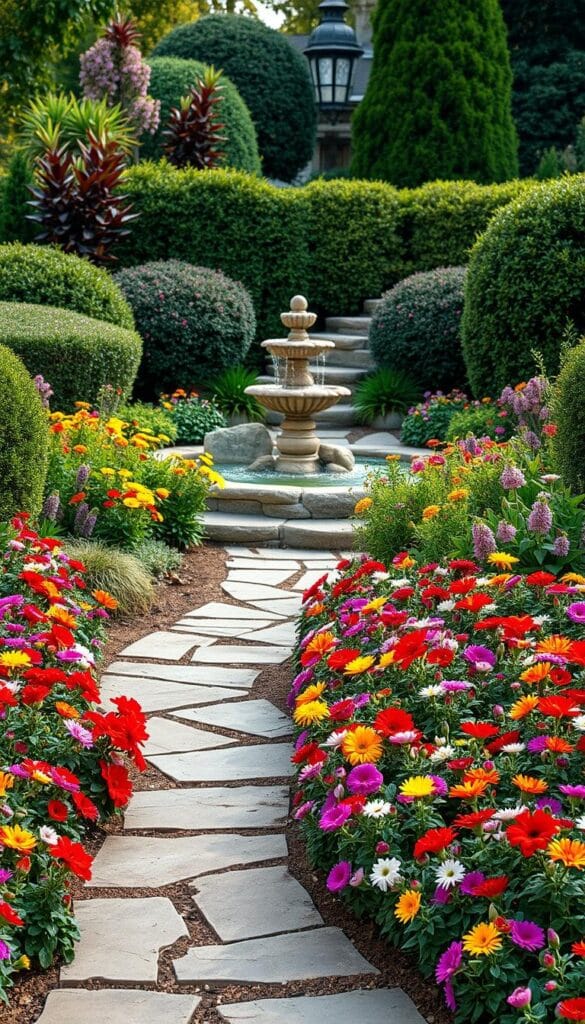
Strategic focal points, like a climbing rose arch or a reflective water feature, can elevate your design. These elements draw the eye and add structure to your space. For example, a rose arch not only adds natural beauty but also creates a sense of depth.
Mixing textures is another way to add visual interest. Pair soft blooms like peonies with bold foliage, such as ornamental grasse, to create layers of depth. This combination keeps your design dynamic and engaging.
“A well-planned garden is like a painting—every color, texture, and focal point works together to tell a story.”
Here’s a quick guide to planning your color and texture combinations:
| Element | Example | Effect |
|---|---|---|
| Complementary Colors | Purple and Yellow | High Contrast |
| Analogous Colors | Blue and Green | Soothing Harmony |
| Focal Point | Rose Arch | Depth and Structure |
| Texture Mix | Peonies and Ornamental Grasse | Visual Depth |
By thoughtfully incorporating color, texture, and focal points, you can transform your outdoor area into a masterpiece. Start experimenting today and let your creativity shine!
Enhancing Your Entryway with Garden Features
Your entryway sets the tone for your entire home—make it unforgettable. With the right garden features, you can create a space that feels both welcoming and intentional. From trellises to container arrangements, these elements can transform your entrance into a standout feature.
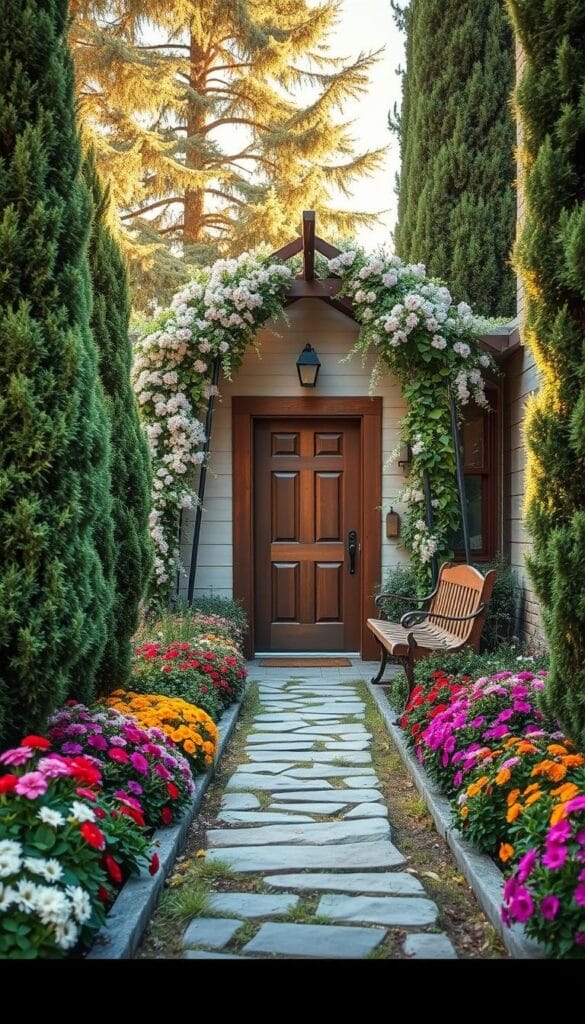
Creative Walkway and Lighting Ideas
A well-designed walkway not only enhances safety but also adds aesthetic appeal. Flagstone paths, for example, create a natural, inviting look that complements any garden. Pairing them with solar-powered lighting ensures your entrance is both beautiful and functional at night.
Accent lighting plays a crucial role in highlighting your pathway. Solar-powered options are energy-efficient and easy to install, making them a practical choice for any homeowner. Strategically placed lights can also draw attention to key features, like a blooming shrub or a decorative trellis.
Mixing different plant types adds depth and interest to your entryway. For example, combining evergreen shrubs with seasonal blooms ensures year-round color and texture. Adding garden ornaments, like a birdbath or a small fountain, can further enhance the charm of your space.
Experimenting with design features allows you to find the perfect balance of function and style. Whether it’s a gently curving path or a cluster of potted plants, each element contributes to a cohesive and inviting entrance. With a little creativity, your entryway can become the highlight of your home.
Embracing the Cottage Garden Charm
There’s something magical about stepping into a space that feels like it’s been plucked from a storybook. A cottage garden, with its overflowing blooms and vintage touches, has a way of making you feel like you’ve stepped back in time. It’s not just about the plants—it’s about creating a space that feels alive, inviting, and full of character.
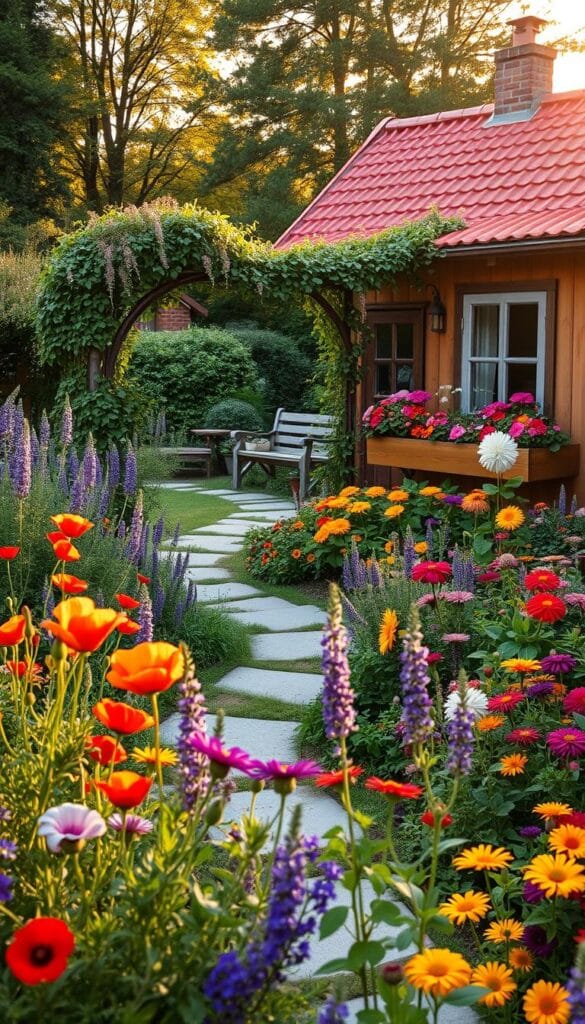
Mixing Annuals, Perennials, and Vintage Accents
One of the secrets to a thriving cottage garden is the mix of annuals and perennials. Annuals like marigolds and poppies bring vibrant color, while perennials like roses and clematis provide structure and longevity. This combination ensures your garden is always in bloom, no matter the season.
Adding vintage accents can elevate the charm of your space. Think weathered fences, antique planters, or even a rustic birdbath. These elements evoke a sense of nostalgia and make your garden feel like it’s been there for generations.
Thoughtful plant selection can also attract beneficial pollinators. Bees and butterflies are drawn to fragrant plants like lavender and roses, which are staples of the cottage garden style. By choosing plants that support local wildlife, you’re not just creating a beautiful space—you’re contributing to the ecosystem.
Here are a few tips to embrace the cottage garden charm:
- Use soft pinks and mauves for a traditional color palette.
- Incorporate climbing plants like rambling roses for vertical interest.
- Add pathways made of weathered bricks or gravel for a natural look.
- Group plants in odd numbers for a more organic arrangement.
The beauty of a cottage garden lies in its relaxed, informal style. It’s a space where plants can grow freely, and creativity can flourish. So, let your imagination run wild and create a garden that feels uniquely yours.
Low-Maintenance and Drought-Tolerant Flower Beds
Imagine a garden that thrives with minimal effort, yet still bursts with color and life. For busy homeowners, low-maintenance flower beds are a dream come true. They save time, conserve water, and still create a lush, vibrant outdoor space. Let’s explore how you can achieve this balance with native plants and smart design.
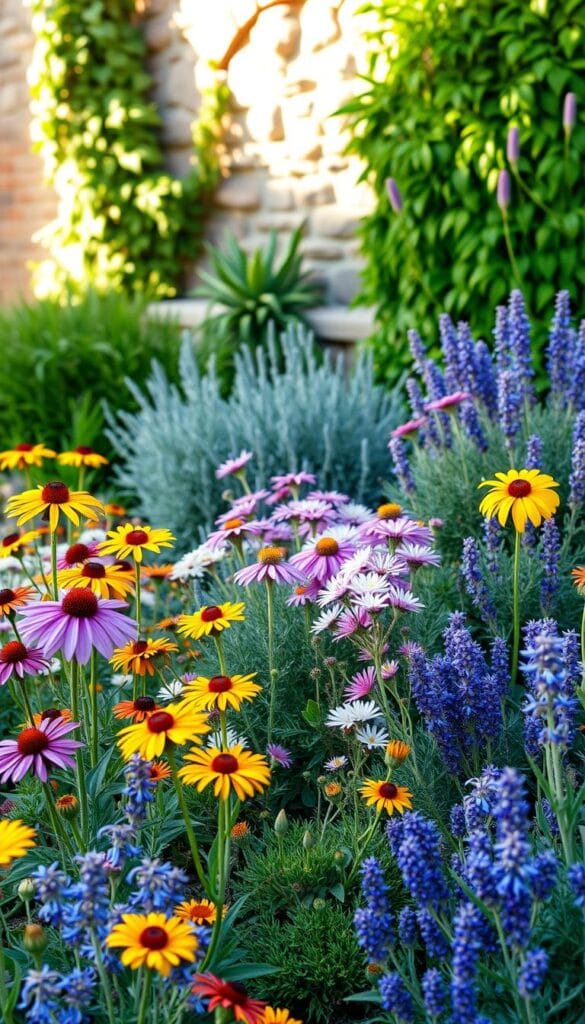
Native Plant Benefits and Water-Wise Tips
Native plants are a game-changer for drought-tolerant gardens. They’re adapted to local growing conditions, which means they require less water and care. Plus, they support local wildlife, like bees and butterflies, making your garden a haven for pollinators.
Here are some water-wise tips to get started:
- Choose plants like Black-Eyed Susan and Purple Coneflower, which thrive in dry conditions and grow up to 5 feet tall.
- Use drip irrigation systems to minimize water loss through evaporation.
- Add compost to your soil to retain moisture and suppress weeds.
Drought-tolerant landscaping can reduce water usage by up to 50%, making it an eco-friendly choice for any garden. Plants like lavender and Russian sage are not only beautiful but also require minimal watering once established.
“A sustainable garden is not just about saving water—it’s about creating a space that thrives naturally.”
Here’s a quick guide to some drought-tolerant plants and their benefits:
| Plant | Height | Benefits |
|---|---|---|
| Lavender | Up to 3 feet | Minimal water, attracts pollinators |
| Russian Sage | Up to 4 feet | Long blooming period, drought-resistant |
| Black-Eyed Susan | Up to 5 feet | Vibrant color, low maintenance |
Incorporating native species and water-wise practices can transform your outdoor space into a sustainable oasis. Whether you’re designing a cottage garden or adding a tree for shade, these tips will help you create a beautiful, low-maintenance landscape.
Creative Ideas for Unique Shapes and Layouts
Ever thought about how a simple curve can transform your outdoor space? Breaking away from traditional square designs can add a fresh, dynamic look to your garden. Unique layouts, like curved or irregular shapes, emphasize the natural flow of your space, making it feel more organic and inviting.

Curved and No-Edging Flower Bed Designs
Curved designs bring softness and movement to your garden. They create a sense of flow, guiding the eye naturally through the space. For example, a gently curving walkway lined with blooming plants can enhance your home’s curb appeal while adding a touch of elegance.
No-edging designs are another way to achieve a naturalistic look. Without rigid borders, your garden blends seamlessly into the surrounding landscape. This approach works especially well in informal settings, where the goal is to create a relaxed, organic feel.
Here are some benefits of these designs:
- Curved layouts add visual interest and break monotony.
- No-edging designs reduce maintenance and create a softer appearance.
- Both styles attract butterflies and other pollinators, enhancing biodiversity.
Real-life examples show how these designs can transform a space. For instance, a curved garden with native plants not only looks stunning but also supports local wildlife. Similarly, a no-edging layout with wildflowers can create a meadow-like effect that’s both beautiful and low-maintenance.
Experimenting with shape and layout allows you to personalize your garden. Whether you prefer soft curves or a natural, borderless look, these ideas can help you create a space that’s uniquely yours. So, why not try something new and see how it transforms your outdoor area?
| Design Type | Benefits |
|---|---|
| Curved Layouts | Adds softness and movement, enhances curb appeal |
| No-Edging Designs | Creates a naturalistic look, reduces maintenance |
| Pollinator-Friendly | Attracts butterflies and supports biodiversity |
Utilizing Vertical Space and Architectural Elements
Have you ever looked at a small outdoor space and wondered how to make it feel larger and more inviting? The answer lies in going vertical. By incorporating trellises, arbors, and raised planters, you can transform even the tiniest area into a lush, functional landscape.
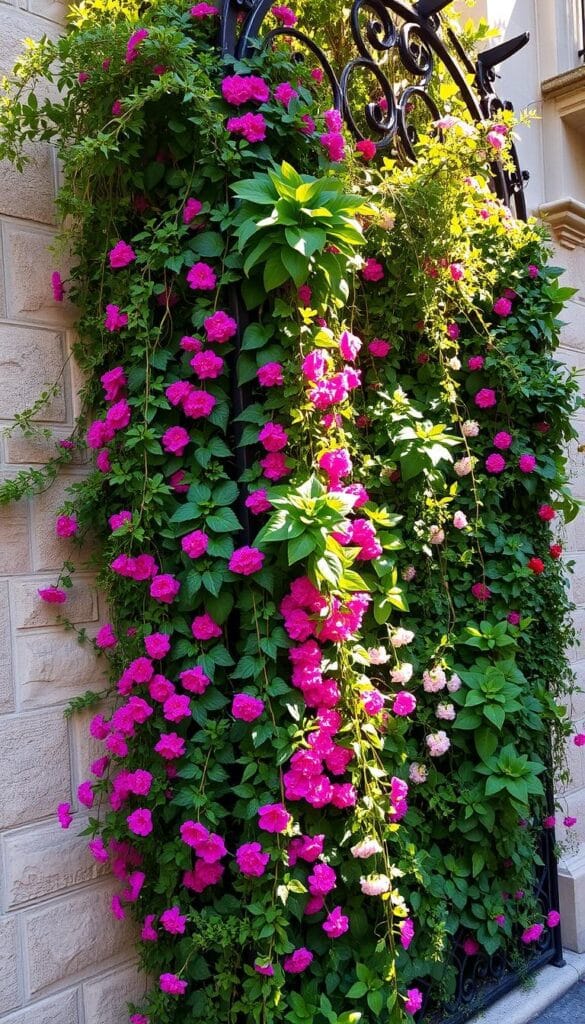
Vertical gardening is a game-changer for maximizing space. It’s perfect for urban environments where outdoor areas are limited. With the right structures, you can grow everything from herbs to climbing plants, adding both beauty and practicality to your garden.
Trellis, Arbor, and Raised Planter Installations
Installing a trellis or arbor is a great way to support climbing plants like roses or clematis. These structures not only add height but also create distinct zones in your garden. For example, an arbor can serve as a stunning entryway, while a trellis can act as a natural divider.
Raised planters are another excellent option. They provide better drainage and soil control, which leads to healthier plant growth. Plus, they’re perfect for growing annuals and herbs, making them both functional and visually appealing.
Here are some practical tips for incorporating vertical elements:
- Choose plants with shallow root systems, like succulents or trailing vines, for vertical gardens.
- Use high-quality, well-drained potting soil to ensure plant health.
- Install solar-powered lighting to highlight your vertical features at night.
Vertical gardening isn’t just about saving space—it’s about creating a dynamic, layered landscape that draws the eye upward. Whether you’re adding a trellis for climbing plants or a raised planter for herbs, these elements can transform your outdoor area into a stunning retreat.
“Vertical gardening is the perfect solution for small spaces, adding both beauty and functionality to your outdoor area.”
By integrating these architectural elements, you can create a garden that’s as unique as it is practical. So, why not take your landscape to new heights?
Sustainable Practices for Eco-Friendly Gardens
What if your garden could not only look beautiful but also help the planet? Sustainable gardening is more than a trend—it’s a way to create a space that’s both stunning and eco-conscious. By adopting water-wise irrigation and mulching techniques, you can reduce your environmental footprint while maintaining a lush, vibrant garden.
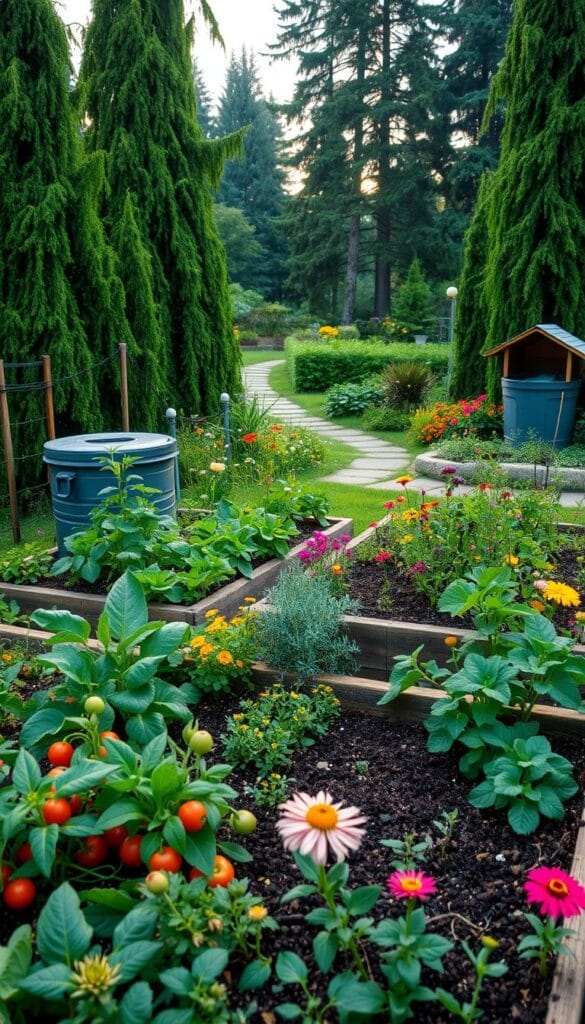
Water-Wise Irrigation and Mulching Techniques
Water-wise irrigation is a game-changer for eco-friendly gardens. Systems like drip irrigation deliver water directly to plant roots, minimizing waste and evaporation. This feature not only conserves water but also ensures your plants stay healthy and hydrated.
Mulching is another essential practice. Organic mulch, such as wood chips or straw, helps retain soil moisture and suppress weeds. It’s a simple yet effective option that adds charm to your garden while supporting plant growth.
Here are some tips for sustainable gardening:
- Use rain barrels to collect and store water for irrigation.
- Choose native plants that require less water and maintenance.
- Apply mulch in layers to maximize moisture retention and weed control.
Eco-friendly materials can also enhance your garden’s charm. For example, recycled bricks or stones make excellent edging options, adding structure and style. These materials are not only sustainable but also durable, ensuring your garden looks great for years to come.
“Sustainability isn’t just about saving resources—it’s about creating a garden that thrives naturally and beautifully.”
By incorporating these practices, you can transform your outdoor space into a sustainable oasis. Whether it’s through water-wise irrigation or thoughtful mulching, every small step makes a big difference. Let’s work together to create gardens that are as kind to the planet as they are to the eye.
Incorporating Modern Minimalist Aesthetics
Have you ever admired a space that feels effortlessly chic and uncluttered? Modern minimalist aesthetics are all about creating a clean, serene environment that speaks volumes with simplicity. By focusing on clean lines, limited color palettes, and functional design, you can transform your outdoor area into a sophisticated retreat that enhances your home’s curb appeal.
Monochromatic Schemes and Sleek Plant Containers
One of the hallmarks of minimalist design is the use of a monochromatic color scheme. Sticking to shades of one color, like soft grays or crisp whites, creates a cohesive and calming look. Pair this with sleek, contemporary plant containers made of materials like concrete or metal for a polished touch. These elements not only look stylish but also reduce visual clutter, making your space feel more open and inviting.
Minimalist landscaping emphasizes simplicity and functionality, which can reduce upkeep costs by up to 30% compared to traditional designs. By choosing low-maintenance plants and streamlined containers, you can enjoy a beautiful garden without the hassle. Native plants, for example, require 50% less water than non-native species, making them a sustainable choice for minimalist gardens.
Here are some tips to achieve a modern minimalist look:
- Use a limited color palette to create harmony and balance.
- Opt for sleek, geometric plant containers for a contemporary touch.
- Incorporate vertical elements like trellises to maximize space and add visual interest.
Real-life examples show how these design choices can subtly enhance your home’s curb appeal. For instance, a monochromatic garden with clean lines and modern containers can make a bold statement while maintaining a sense of calm. Adding a single focal point, like a sculptural plant or a water feature, can elevate the design without overwhelming the space.
Blending minimalism with personal style allows you to create a garden that feels uniquely yours. Whether it’s through the use of neutral tones or the strategic placement of sleek containers, these design choices can transform your outdoor area into a modern masterpiece. So, why not embrace simplicity and let your garden shine?
| Element | Benefit |
|---|---|
| Monochromatic Palette | Creates harmony and reduces visual clutter |
| Sleek Containers | Adds a contemporary touch and reduces maintenance |
| Native Plants | Requires less water and supports sustainability |
Practical Tips for Ongoing Garden Maintenance
Keeping your garden looking its best doesn’t have to be overwhelming—with the right strategies, it can be simple and rewarding. Regular maintenance ensures your outdoor space stays healthy, vibrant, and inviting. Let’s dive into some practical tips to keep your garden thriving.
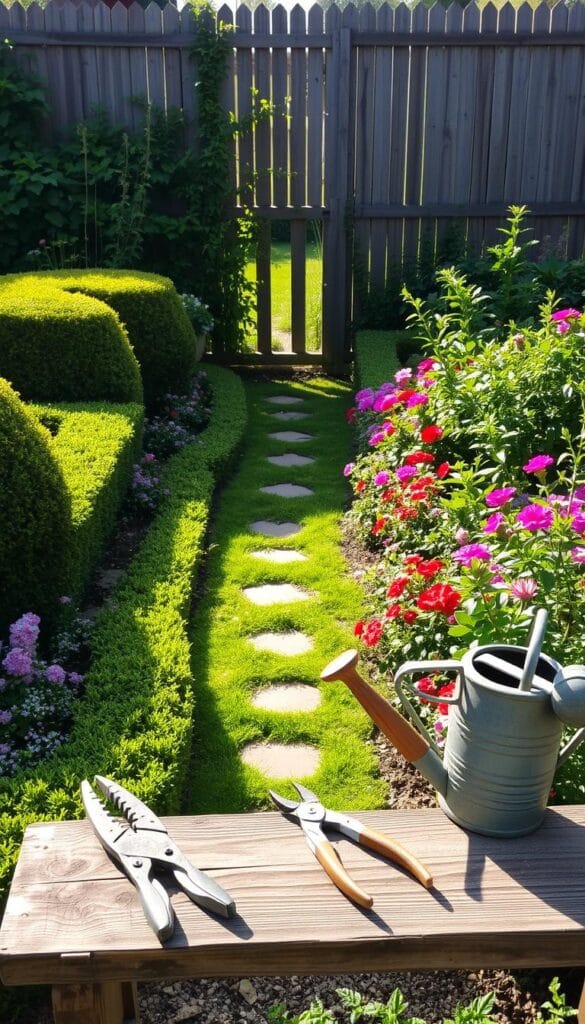
Regular Pruning, Weeding, and Mulching Strategies
Pruning is essential for maintaining the shape and health of your plants. By trimming back overgrown branches, you encourage new growth and prevent disease. For example, shrubs like linden viburnum only need pruning once a year, making them a low-maintenance choice.
Weeding is another crucial task. Weeds compete with your plants for nutrients, water, and light. Using simple tools like a hoe or hand trowel can make this job easier. Regular weeding keeps your garden looking neat and prevents invasive species from taking over.
Mulching is a game-changer for garden maintenance. A layer of organic mulch, like wood chips, helps retain moisture and suppress weeds. It also adds a polished look to your pathway and creates a stone-like edge effect. Applying 3 inches of mulch between plants ensures optimal soil health.
Here are some quick tips to make maintenance easier:
- Prune plants in early spring to encourage healthy growth.
- Weed regularly to prevent overgrowth and maintain a clean look.
- Use mulch to conserve water and define your garden’s edges.
Ongoing maintenance is key to preserving the beauty and longevity of your landscape. By incorporating these strategies, you can create a garden that’s both stunning and sustainable. So, grab your tools and let’s get started!
Inspiration from Leading Landscape Designers
Ever wondered how top designers create those jaw-dropping outdoor spaces? I’ve always been fascinated by the creativity and precision that goes into professional landscape design. From innovative planting techniques to stunning vegetable arrangements, there’s so much to learn from the experts. Let’s explore some real-life examples and social media insights that can inspire your own projects.
Real-Life Examples and Social Media Insights
Designers like Tim Murphy and Bob Stefko are masters at transforming ordinary spaces into extraordinary landscapes. Their work often features unique planting strategies that maximize visual impact. For instance, combining perennials with annuals ensures year-round color and interest. Social media influencers like @ladylandscape also share creative ideas, from vertical gardens to edible landscapes, that are both beautiful and functional.
Here are some key takeaways from their projects:
- Innovative Planting Techniques: Layering plants of varying heights creates depth and texture, making your space feel more dynamic.
- Vegetable Arrangements: Integrating vegetables like kale or peppers into your design adds both functionality and visual appeal.
- Year-Round Beauty: Choose plants with staggered bloom times to ensure your garden looks vibrant every season.
“A well-designed garden is a reflection of thoughtful planning and creativity. Don’t be afraid to experiment and make it your own.”
One of my favorite examples is a project that combined raised beds with climbing plants. This not only saved space but also added vertical interest. The designer used a mix of vegetables and flowers, creating a space that was both practical and stunning.
Adapting these professional ideas to your own space is easier than you think. Start small by experimenting with a single planting technique or adding a few vegetables to your existing garden. Over time, you’ll develop a style that’s uniquely yours.
So, why not take inspiration from the pros and start transforming your outdoor space today? With a little creativity and planning, you can create a garden that’s both beautiful and functional, no matter the size or location.
Conclusion
Transforming your outdoor space into a vibrant retreat is easier than you think. Throughout this article, we’ve explored creative ways to design a space that not only looks stunning but also feels alive. Thoughtful plant selection and layout can breathe new life into your home’s exterior, making it a welcoming haven for both you and beneficial wildlife.
Whether you’re drawn to native plants that thrive with minimal care or colorful arrangements that change with the seasons, these ideas can inspire your next project. Homes with well-maintained landscaping can sell for up to 10% more, proving that a beautiful garden is both an aesthetic and financial investment.
Now it’s your turn to take action. Start small—maybe with a few native plants or a seasonal bloom—and watch your space transform. A well-designed garden doesn’t just add beauty; it creates a connection to nature that’s truly rewarding. So, grab your gloves and let’s bring your outdoor vision to life today!
FAQ
How can I create a stunning flower bed that enhances my home’s curb appeal?
Start by choosing a mix of plants with varying heights, textures, and colors. Layer them strategically, placing taller plants like shrubs or roses at the back and shorter blooms like herbs or grasses in front. Add edging materials like stone or pathways to define the space and create a polished look.
What are some low-maintenance options for a yard flower bed?
Opt for native plants, drought-tolerant species, or perennials that require less watering and care. Incorporate mulch to retain moisture and reduce weeds. Adding pollinator-friendly plants like butterfly bushes can also attract wildlife while keeping maintenance minimal.
How do I choose the right plants for year-round color?
Combine seasonal blooms like spring bulbs with evergreens or shrubs that provide structure. Mix in annuals for continuous color and perennials that return each year. Using a color wheel can help you create a harmonious palette that changes with the seasons.
What are some creative ways to design a flower bed with unique shapes?
Experiment with curved layouts or no-edging designs for a natural, flowing look. Incorporate vertical elements like trellises or raised planters to add dimension. You can also use pathways or walkways to guide the eye and create visual interest.
How can I incorporate sustainable practices into my garden?
Use water-wise irrigation systems like drip hoses and mulch to conserve water. Choose native plants that thrive in your climate and require fewer resources. Composting and avoiding chemical fertilizers can also make your garden more eco-friendly.
What are some tips for maintaining a flower bed throughout the year?
Regularly prune plants to encourage healthy growth and remove weeds to keep the area tidy. Mulch annually to retain moisture and suppress weeds. Deadhead spent blooms to promote new growth and keep your garden looking fresh.
How can I add a cottage garden charm to my space?
Mix a variety of plants like roses, herbs, and grasses for a relaxed, whimsical feel. Add vintage accents like rustic planters or a stone pathway. Focus on creating a mix of colors and textures to achieve that cozy, timeless look.
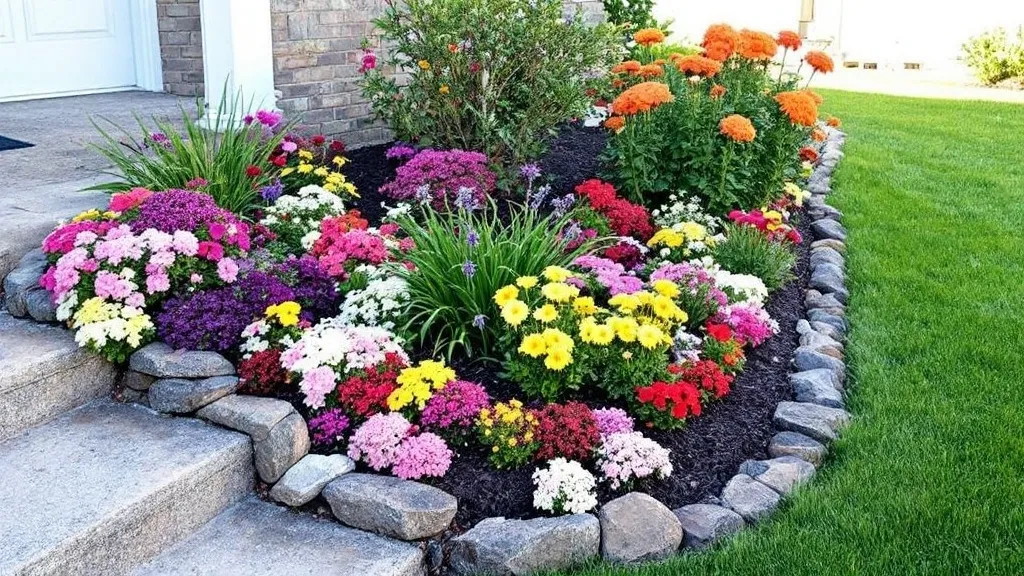
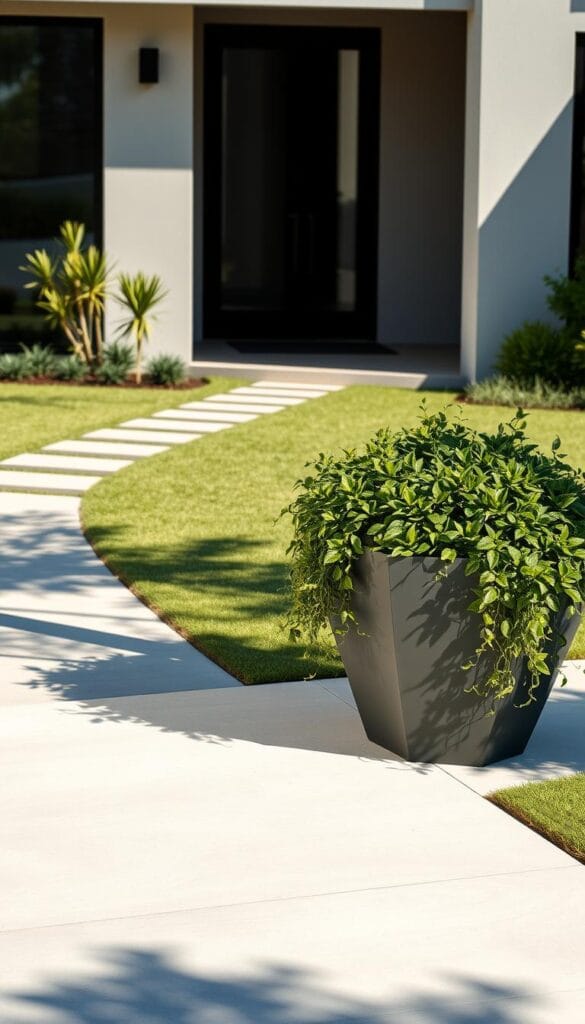
I simply could not go away your web site before suggesting that I really enjoyed the usual information an individual supply for your visitors? Is gonna be back continuously to check up on new posts
Este site é realmente fantástico. Sempre que consigo acessar eu encontro novidades Você também pode acessar o nosso site e saber mais detalhes! informaçõesexclusivas. Venha saber mais agora! 🙂
I like this post, enjoyed this one thank you for posting. “No trumpets sound when the important decisions of our life are made. Destiny is made known silently.” by Agnes de Mille.
Everything is very open and very clear explanation of issues. was truly information. Your website is very useful. Thanks for sharing.